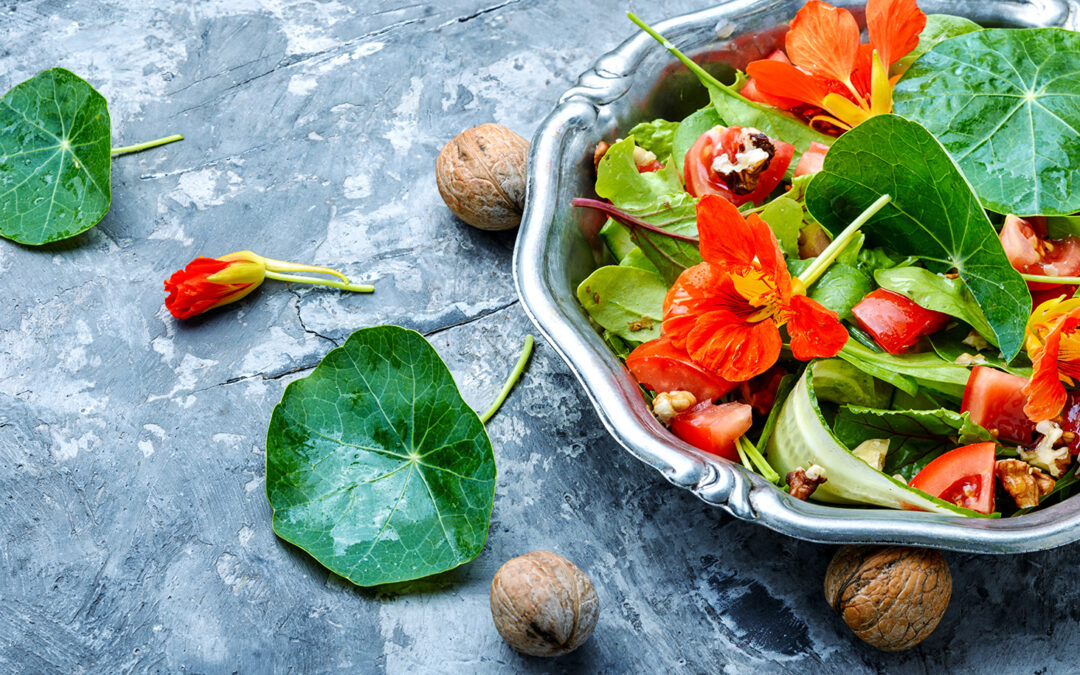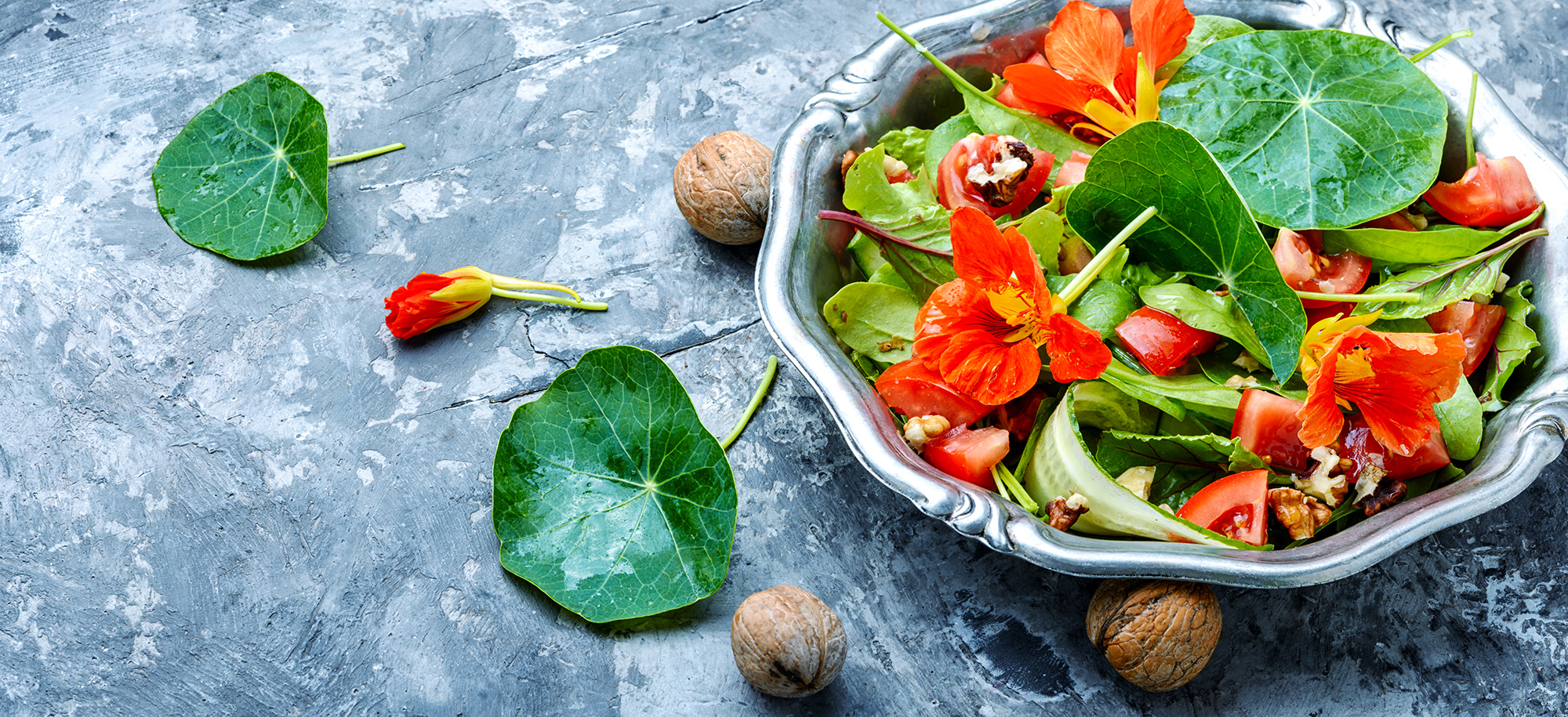Eating flowers is a practice that has deep roots in humanity’s history. More recently, the only place you might see an edible flower is on a fancy dessert at an expensive restaurant (and, chances are, you probably put it to the side). Why should we start eating flowers again? What role have edible flowers played in history and medicine?
An Unknown Beginning
Eating flowers goes back to the beginning of time. There’s no identifiable point in history that this practice began. Ancient Roman, Greek, and Chinese herbalists had plenty to say on the benefits of eating flowers. Incas, Aztecs, and Hindus also chose to include edible flowers in some of their religious rituals.
A Short History Lesson, Featuring Your Favorite Flowers
History shows that some of our garden favorites are more than just a pretty face: they have a fascinating back-story and practical uses today!
Calendula
Calendula is one of the most universally recognized edible flowers, making an appearance in nearly every ancient culture. Records show that its cultivation goes back some 600 years, playing an important role in French and English culture.
Romans frequently used Calendula to give their food a saffron-like tinge, dubbing this herb “Poor-Man’s Saffron.”
Ancient Monks nicknamed Calendula “Pot Marigold” because they so commonly used it in soups and stews.
Yet another title that identifies Calendula is “Mary’s-Gold,” a name surrounded by folklore from the 1200s. Rumor has it that a beautiful, golden-haired girl who sat and watched the sun each day suddenly disappeared, the delightfully yellow flower emerged, the girl was never to be found again, and her friends declared that she had turned into a plant.
Fast forward to the 1800s, when doctors realized that Calendula was helpful as a poultice, stopping bleeding and encouraging wounds to heal. On battle lines, doctors would carry dried Calendula flowers to apply to their injured patients.
Using Calendula Today
Calendula is used by modern herbalists to help with ulcers, wound healing, relieve muscle fatigue, and regulate menstruation. The flower’s green base is where most of the Calendula’s “medicine” resides; petals do not have the same medicinal oomph but still have some value.
Nasturtium
These natives of Columbia, Peru, and Bolivia made their entry into European life by Spanish conquistadors in the 1600s. Their climbing abilities earned them their scientific name, Tropaeolum Minor, which comes from the Greek word meaning “to twine.”
Victorian English women would include Nasturtiums in their “Tussie Mussies” (in medieval times, these were small bouquets given as gifts or carried instead of wearing jewelry) for their fragrance and symbolism of victory!
It wasn’t too long until everyone decided Nasturtiums tasted just as good as they looked. Their seeds were soaked in vinegar and used as caper-substitutes, and their leaves and flowers added extra peppery flavor to salads.
Using Nasturtium Today
Modern herbalists use Nasturtium to help treat respiratory issues, such as bronchitis and congestion, in addition to urinary tract infections. Since Nasturtium is a natural antibacterial agent, some use it to sanitize wounds, while others focus on taking it internally (through tea or their diet).
Borage
These buds have a long history of being included in salads, reaching back before 1390. With their light cucumber-like flavor, Borage became a fast favorite and a “cure” for nearly everything. An herbalist in the 1700s reports that a regular intake of “distilled water of Borage” would cheer you up, reduce your risk of fainting spells, and ward off “melancholy and tormented dreams,” among a few other things.
The use of Borage flowers went beyond the drawing-rooms of tightly-corseted, depressed English ladies, however. It is also known as “the herb of courage.” Borage was mixed with wine and given to nervous Celtic warriors before battle to provide calm and courage. These soldiers would sew a Borage flower on their sleeveless coat, under their suit of armor, to remind them to cheer up and be brave!
Using Borage Today
Sure enough, the medieval knights had one thing right: even modern herbalists use Borage to help treat depression. As a natural anti-inflammatory agent, some have found success in treating asthma and rheumatoid arthritis with Borage.
Feverfew
The Greeks nicknamed this cheery, daisy-like flower “Parthenium” because (rumor has it) doctors used it to save the life of someone who had fallen from the Parthenon during its construction in the 5th century BC.
The common name “Feverfew” comes from the plant’s antipyretic (fever-reducing) qualities. It’s known as the “aspirin” of the 1800s: treating fevers, colds, and headaches.
There’s a possibility that Feverfew also fits the description of “parthenion” (which means “maidenly” in Greek) because it has been widely used to regulate menstruation and ease labor pains.
Using Feverfew Today
Feverfew also has extensive anti-inflammatory properties, which gives it similar modern-day uses to Borage. Most commonly, it is used to treat migraines and tension headaches.
A Bitter End to Edible Flowers
Interestingly, while there’s no identifiable beginning, there is an identifiable end to the common practice of eating flowers: the industrialization of food. Once everyone started purchasing food instead of growing their own, edible flowers became a novelty.
A Hopeful Comeback
Recently, there has been more interest in organic farming and natural living. We are all smitten with the idea of “farm to table.” We want to use every bit of what we grow, including the mesmerizing buds!
With more recognition of “natural living,” the medicinal uses of flowers have come out of the closet and into broad daylight as well.



Looking forward to my plants arriving!
How would you use fever few? The uses of edible flowers is interesting. But it would help if you included how to use them — eat the petals? infuse the leaves? Make tea?
Am interested in learning about edibles.
Violet flowers have a very high vitamin C content.
Dandelion flowers can be used to make wine.
You are eating flower buds when you eat broccoli.
I’ve had rose petal wine.
Hibiscus flowers are edible and can be used to make tea.
Dill flowers are used to make pickles.